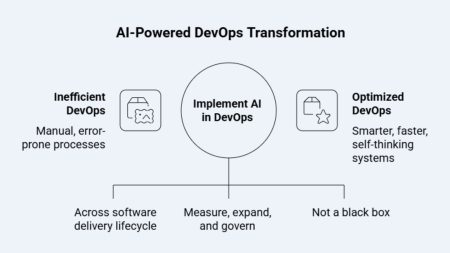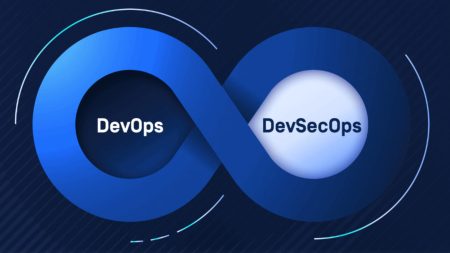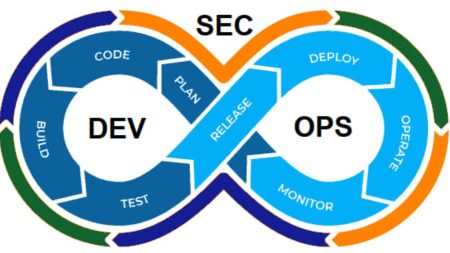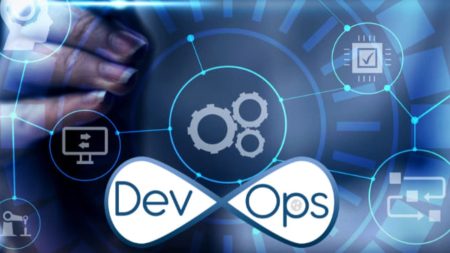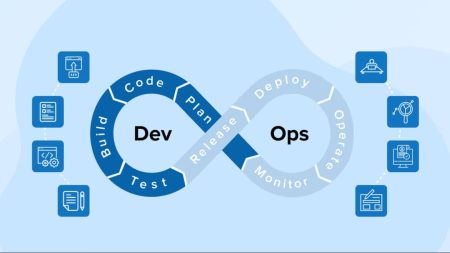A Life Hack for Lightning-Fast Software Delivery
Imagine you’re in the process of baking a cake, but rather than combining all the ingredients simultaneously, you incorporate them one at a time, sampling the batter after each addition. It may seem tedious, doesn’t it? Now envision a fantastical kitchen where every adjustment is immediately evaluated, and the oven chimes with a flawless cake every single time. That’s the essence of CI/CD in DevOps for software development – it’s the secret ingredient for delivering top-notch code at lightning speed. But what does CI/CD in DevOps truly mean? Let’s delve into this revolutionary DevOps methodology, break down its components, and discover how it reshapes the way teams create software.
Breaking the Heart of CI/CD Down
CI/CD stands for Continuous Integration and Continuous Delivery (or Deployment, depending on who you ask). It’s a set of practices that streamline how code moves from a developer’s keyboard to a user’s screen. Think of it as a conveyor belt in a factory, where each piece of code is polished, tested, and shipped without a hitch. Why does this matter? Because in today’s world, where 90% of companies report using cloud services (according to a 2023 Flexera report), speed and reliability are non-negotiable.

So, what is CI and CD in DevOps? Continuous Integration (CI) is about developers frequently merging their code changes into a shared repository – often multiple times a day. Each merge triggers automated tests to catch bugs early. Continuous Delivery (CD), on the other hand, takes this further by automatically preparing code for release to production. Sometimes, CD extends to Continuous Deployment, where every change is automatically deployed to users. Confused yet? Don’t worry, it’s like learning to ride a bike – wobbly at first, but smooth once you get the hang of it.
Why CI/CD Feels Like a Life Hack?
Ever tried juggling while riding a unicycle? That’s what software development can feel like without CI/CD. Developers used to spend hours – sometimes days – manually testing and deploying code. A 2022 GitLab survey found that teams without CI/CD lost 20% of their development time to manual processes. With CI/CD, that time shrinks dramatically. It’s like swapping a horse-drawn carriage for a sports car. Teams can focus on writing code, not babysitting builds.
The First Half of the Equation
Let’s zoom in on CI. What is CI in DevOps? It’s the practice of integrating code changes into a central repository frequently. Each integration runs through a gauntlet of automated tests – unit tests, integration tests, you name it. If a test fails, the team knows instantly, like a smoke alarm blaring before a fire spreads. This rapid feedback loop catches bugs early, saving time and headaches.
For example, imagine a team of five developers working on a mobile app. Without CI, one coder’s mistake could break the entire app, and no one would notice until days later. With CI, automated tests run every time code is pushed, flagging issues in minutes. A 2023 CircleCI report showed that teams using CI reduced bug-related delays by 30%. That’s not just efficiency – it’s peace of mind.
How CI Works in Practice?
Here’s the play-by-play: A developer writes code and commits it to a version control system like Git. The CI system – think Jenkins, GitLab CI or CircleCI – detects the change and kicks off a build. It compiles the code, runs tests, and generates a report. If everything’s green, the code is ready for the next step. If not, the developer gets a nudge to fix it. It’s like having a tireless assistant who double-checks your work 24/7.
|
Aspect |
With CI |
Without CI |
|---|---|---|
|
Bug Detection |
Immediate, via automated tests |
Delayed, often manual |
|
Code Integration |
Multiple times daily |
Weekly or less |
|
Team Collaboration |
Seamless, shared repository |
Siloed, merge conflicts common |
The Bridge to Production
Now, let’s talk about CDs. What is CD in DevOps? Continuous Delivery picks up where CI leaves off, automating the process of getting code ready for release. Once the code passes CI’s tests, it’s packaged and deployed to a staging environment for further checks. The catch? Deployment to production still requires a human to hit the “go” button. It’s like prepping a rocket for launch but waiting for mission control’s approval.
Continuous Deployment, however, takes it a step further. Every change that passes tests is automatically pushed to production. No manual approval, no delays. Think of it as a self-driving car versus one with a driver who needs to check the map. According to a 2024 DORA report, teams using Continuous Deployment release code 208 times more frequently than low-performing teams. That’s the difference between a trickle and a tidal wave.
The Difference Between CI and CD in DevOps
So, what’s the difference between CI and CD in DevOps? CI is about building and testing code reliably, while CD is about delivering that code to users – either with a manual gate (Continuous Delivery) or automatically (Continuous Deployment). CI ensures your code is solid; CD ensures it reaches the finish line. Together, they’re like peanut butter and jelly – great alone, unstoppable together.
|
Feature |
Continuous Integration |
Continuous Delivery |
Continuous Deployment |
|---|---|---|---|
|
Automation Scope |
Code building and testing |
Code delivery to staging |
Automatic production release |
|
Manual Intervention |
None |
Required for production |
None |
|
Speed of Release |
N/A |
Fast |
Fastest |
CI/CD Tools in DevOps are Your Trusty Sidekicks
No superhero fights crime without gadgets, and no DevOps team thrives without CI/CD tools in DevOps. These tools are the backbone of automation, handling everything from code integration to deployment. Popular ones include Jenkins, GitLab CI, CircleCI, GitHub Actions and Azure DevOps (DaaS). Each has its strengths, like a multitool versus a specialized tool.
For instance, Jenkins is open-source and highly customizable, with over 1,800 plugins (as per Jenkins’ 2023 documentation). GitLab CI, on the other hand, integrates tightly with GitLab’s version control, making it a one-stop shop. A 2023 Stack Overflow survey found that 47% of developers use GitHub Actions for CI/CD, thanks to its seamless GitHub integration. Choosing the right tool depends on your team’s needs, like picking the perfect coffee blend for your morning brew.
Popular CI/CD Tools in DevOps
graph TD
A[CI/CD Tools] --> B(Jenkins)
A --> C(GitLab CI)
A --> D(CircleCI)
A --> E(GitHub Actions)
A --> F(Azure DevOps)
B -->|Open-source, 1,800+ plugins| G(Customizable)
C -->|Integrated with GitLab| H(Streamlined)
D -->|Cloud-based| I(Fast setup)
E -->|GitHub integration| J(Popular)
F -->|Enterprise focus| K(Robust)
Why CI/CD in DevOps is a Game-Changer?
Ever wonder why some companies ship new features weekly while others take months? CI/CD in DevOps is the answer. It’s not just about speed – it’s about reliability, collaboration, and customer satisfaction. A 2024 Puppet State of DevOps report revealed that high-performing CI/CD teams achieve 50% fewer deployment failures than their peers. That’s like landing a plane smoothly every time, even in a storm. But it’s not all sunshine and rainbows. Setting up CI/CD can be a hurdle. Teams need to configure pipelines, write tests, and sometimes overhaul their workflows. It’s like renovating a house while living in it – messy but worth it. Once in place, CI/CD saves time, reduces errors, and lets developers focus on creating, not fixing.
Real-World Wins with CI/CD
Take Netflix, for example. They deploy thousands of times daily, thanks to their robust CI/CD pipelines (as noted in a 2023 Netflix tech blog). Their secret? Automated testing and deployment, powered by tools like Spinnaker. Or consider Etsy, which went from monthly releases to over 50 daily deployments after adopting CI/CD (per a 2022 Etsy case study). These aren’t just tech giants flexing muscle – they’re proof CI/CD works for teams willing to commit.
Overcoming CI/CD Challenges
Nothing’s perfect, and CI/CD has its quirks. Setting up pipelines can feel like assembling a 1,000-piece puzzle. Tests need to be comprehensive, or you’re just kicking the can down the road. And cultural resistance? Oh, it’s real – some teams cling to old workflows like a kid to a favorite toy. A 2023 Atlassian report found that 25% of teams struggle with CI/CD adoption due to lack of expertise. So, how do you overcome this? Start small. Automate one test, then ten, then a hundred. Train your team, lean on CI/CD tools in DevOps, and celebrate small wins. Before long, you’ll wonder how you ever survived without it. It’s like switching from a flip phone to a smartphone – once you do, there’s no going back.
CI/CD Adoption Challenges
graph LR
A[CI/CD Challenges] --> B(Setup Complexity)
A --> C(Test Coverage)
A --> D(Cultural Resistance)
B -->|Solution| E(Start small, scale up)
C -->|Solution| F(Invest in test automation)
D -->|Solution| G(Training and buy-in)
The Human Side of CI and CD in DevOps
Let’s get real for a second. CI/CD isn’t just about code – it’s about people. Developers, testers, and ops folks all need to row in the same direction. CI/CD fosters collaboration, like a band jamming in perfect harmony. Without it, teams are like musicians playing different songs at once – chaos. A 2024 Google Cloud study showed that teams with strong DevOps cultures (including CI/CD) report 30% higher employee satisfaction. Happy teams, happy code, happy users. Also, CI/CD empowers developers. No more late-night debugging sessions or “it works on my machine” excuses. Automated pipelines catch issues early, giving teams confidence to ship fast. It’s like having a safety net while walking a tightrope.
CI/CD as a Life Hack for DevOps
Here’s the kicker: CI/CD in DevOps isn’t just a process – it’s a mindset. It’s about embracing automation, collaboration, and relentless improvement. Think of it as a fitness routine for your codebase – consistent, disciplined, and transformative. By integrating and delivering code continuously, teams can ship features faster, fix bugs quicker, and keep customers smiling.
To sum up, what is CI/CD in DevOps? It’s the art of making software development predictable, efficient, and dare I say, fun. Whether you’re a startup or a tech titan, CI/CD tools in DevOps can shave weeks off your release cycles. So, why wait? Dive into CI/CD, experiment with tools, and watch your team soar. After all, in the fast-paced world of software, standing still is like trying to win a race on a treadmill – you’re not going anywhere.


